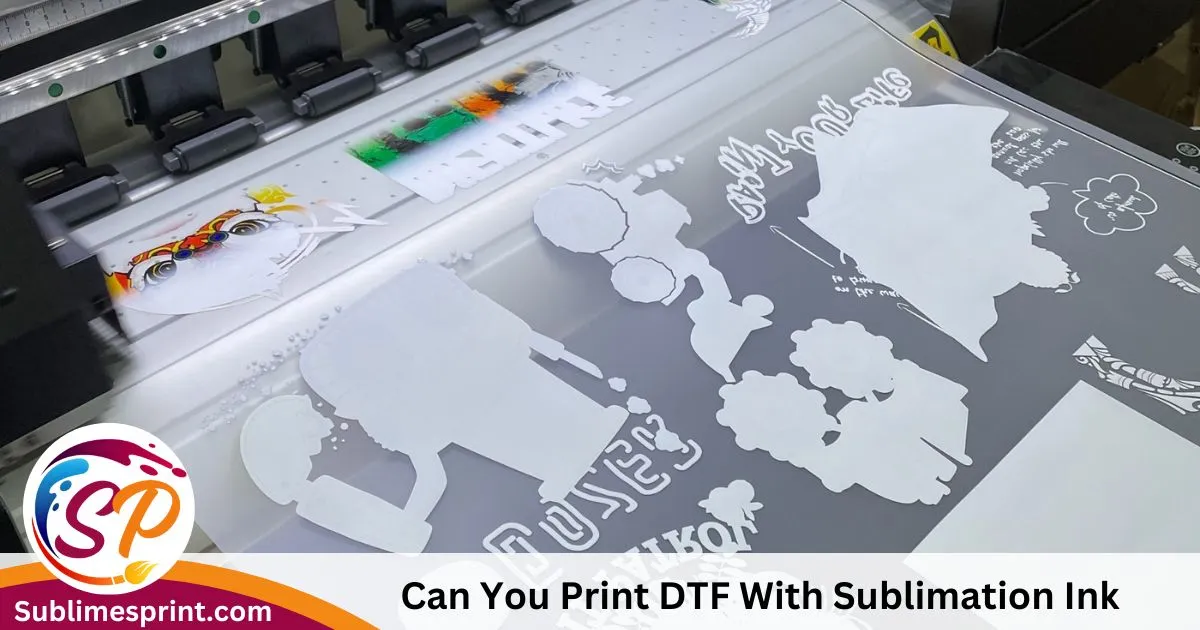In the ever-evolving realm of custom apparel printing, staying ahead of the curve is the key to success. One such innovation that has been making waves in the industry is DTF Printing, a technique that brings a new dimension to the world of vibrant and high-quality designs on apparel. What makes this method truly remarkable is its marriage with Sublimation Ink, a game-changer in the printing landscape.
Let’s talk about DTF printing with sublimation ink. Keep in mind, that sublimation ink is see-through, so it really shines on whites and light colors. Sure, you can try it on dark fabrics, but for top-notch quality, DTF is the way to go. Trust me, sublimation printers might not give you that pop on dark materials. So, stick to the light side for the best results! 🌈👕
Yup, you can use sublimation printers for DTF transfers, but here’s the catch – they don’t do white ink. So, your canvas is kinda limited to light and white t-shirts. Keep it bright and you’re good to go!
The Evolution of Printing Technologies
Before we embark on the journey of mastering DTF printing with sublimation ink, let’s take a moment to appreciate the evolution of printing technologies. From the humble beginnings of traditional screen printing to the more advanced digital methods, the quest for higher quality and efficiency has been a driving force.
Enter DTF Printing and Sublimation Ink
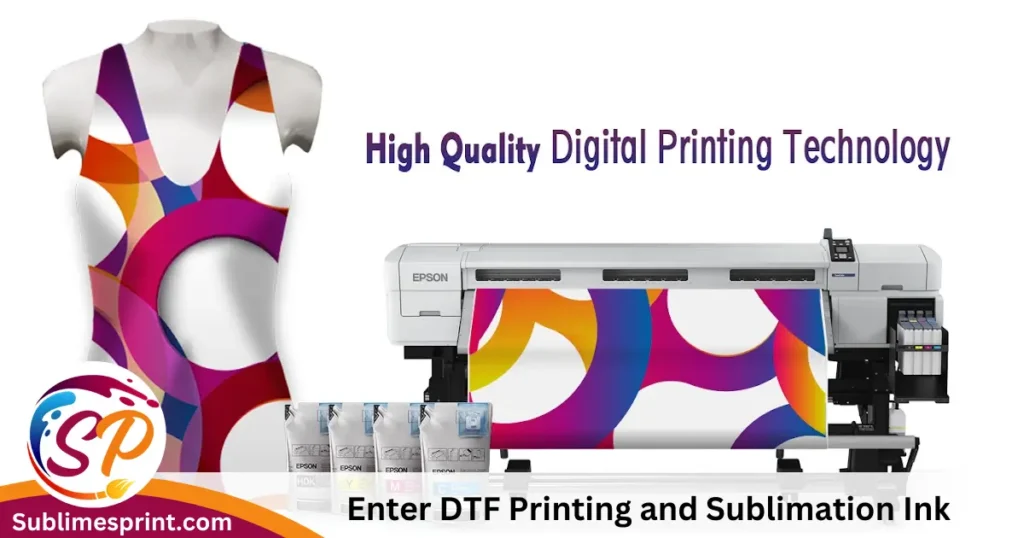
Now, picture this: Direct to Film (DTF) printing allows you to transfer intricate designs directly onto your chosen fabric, eliminating the need for cumbersome intermediate steps. It’s like bringing your imagination to life with unprecedented clarity and precision. But what elevates DTF to new heights is the use of Sublimation Ink.
Significance of Sublimation Ink in DTF Printing
Sublimation ink is not your ordinary ink; it’s a wizard in the world of colors. This special ink has the ability to transform from a solid to a gas without passing through the liquid stage—a process known as sublimation. When used in DTF printing, this unique characteristic ensures that your designs permeate the fabric, resulting in prints that are not only vibrant but also exceptionally durable.
The Promise of Innovation and Quality
For print shop owners like you, the promise of innovation and enhanced print quality is a game-changer. Imagine offering your customers designs that not only look stunning but also withstand the test of time. DTF printing with sublimation ink opens up a realm of possibilities, allowing you to push the boundaries of what your print shop can achieve.
In the following sections of this comprehensive guide, we’ll delve deeper into the intricacies of DTF printing and sublimation ink. From understanding the DTF printing process to practical tips for integrating this technique into your print shop, we’ve got you covered. So, fasten your seatbelt as we embark on this exciting journey into the world of DTF printing innovation.
Understanding DTF Printing
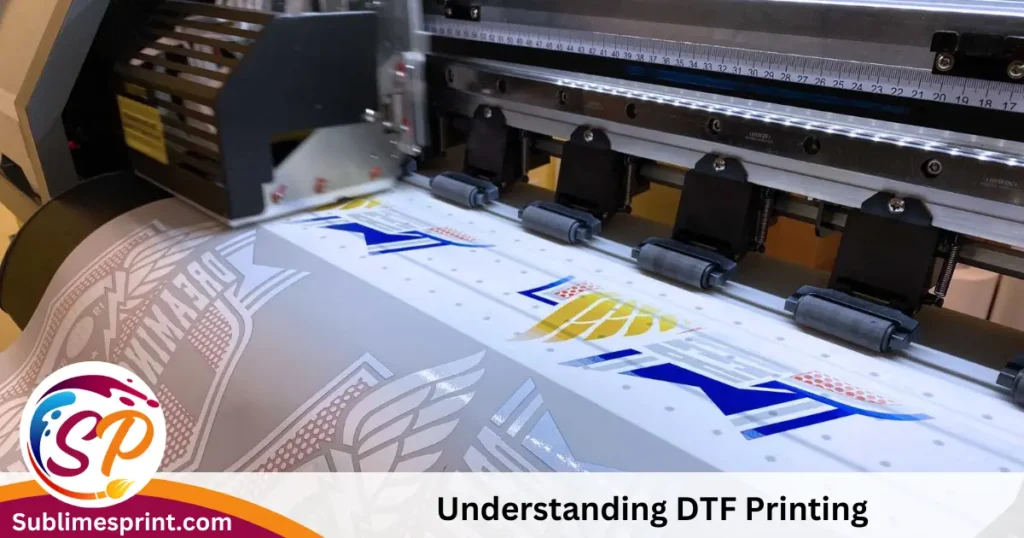
Now that we’ve set the stage for the revolution that is DTF printing with sublimation ink, let’s dive into the nitty-gritty of what makes DTF a game-changer for custom apparel businesses.
Definition and Essence of DTF Printing
DTF printing stands for Direct to Film printing, a technique that skips the traditional transfer paper step. Instead, the design is directly printed onto a special film, which is then transferred onto the fabric. This direct approach eliminates the potential loss of detail seen in some other printing methods, ensuring that your designs are as sharp and vivid as you envisioned.
How DTF Differs from Traditional Methods
In traditional printing methods, a transfer paper is used as an intermediary carrier for the design. This extra step can sometimes result in a loss of clarity or color vibrancy. DTF printing cuts out this middleman, allowing for a more direct and precise application of the design onto the fabric. The result? Crisp, detailed prints that truly stand out.
Benefits of Adopting DTF in Your Print Shop
So, why should you consider embracing DTF printing in your print shop? The benefits are manifold.
- Precision and Detail: DTF printing ensures that every nuance of your design is faithfully reproduced on the fabric. Intricate details, fine lines, and gradients are all captured with unparalleled precision.
- Versatility: DTF printing is not limited to specific fabrics or garment types. Whether you’re working with cotton, polyester, or a blend, DTF can be adapted to suit various materials.
- Efficiency: The direct process of DTF printing can save you time and resources. With fewer steps involved, you can streamline your production workflow without compromising on quality.
The Canvas for Your Imagination
Imagine having a canvas that can effortlessly translate your creative visions into tangible, wearable art. That’s what DTF printing offers—a canvas for your imagination to run wild. Whether you’re a seasoned print shop owner or just starting in the industry, the simplicity and effectiveness of DTF printing can elevate your designs to new heights.
In the next section, we’ll delve into the magic behind DTF printing—the role of sublimation ink. Get ready to uncover the secrets of this transformative ink that brings your designs to life in a way you never thought possible.
Read also: What Is Sublimation Spray Used For?
Sublimation Ink: The Artistry Behind DTF Printing
Welcome to the realm of colors, where ordinary transforms into extraordinary. In the context of DTF printing, one cannot overlook the pivotal role played by sublimation ink. Let’s unravel the magic behind this ink and understand why it’s the secret sauce to vibrant and long-lasting prints.
The Unique Properties of Sublimation Ink
At its core, sublimation ink is a marvel of science and artistry. Unlike traditional inks, sublimation ink has the remarkable ability to transition from a solid to a gas without passing through the liquid phase—a process known as sublimation. This unique characteristic is what sets it apart and makes it an ideal companion for DTF printing.
Vibrancy Beyond Limits
When sublimation ink undergoes sublimation, it transforms into a gaseous state, allowing it to penetrate the fabric on a molecular level. This results in prints that are not only vibrant on the surface but are ingrained into the very fibers of the fabric. The colors come to life with a richness and depth that simply cannot be achieved with traditional inks.
Durability that Stands the Test of Time
One of the key advantages of sublimation ink lies in its durability. Since the ink becomes a part of the fabric, rather than sitting on top of it, the prints are less prone to fading, cracking, or peeling. This longevity is a crucial factor, especially for custom apparel businesses aiming to deliver quality that withstands the rigors of time and wear.
Versatility in Printing on Various Materials
Sublimation ink isn’t limited by the type of fabric. Whether you’re working with polyester, a polyester blend, or even hard surfaces like ceramics or metals, sublimation ink can adapt. This versatility opens up a world of possibilities for print shop owners, allowing them to cater to a diverse range of customer preferences and requests.
Choosing the Right Sublimation Ink for Your Business
Now that we’ve explored the wonders of sublimation ink, it’s essential to understand that not all sublimation inks are created equal. When integrating DTF printing with sublimation ink into your print shop, choose a high-quality sublimation ink that aligns with your business goals and the types of designs you envision.
Integrating DTF into Your Print Shop
Now that we’ve uncovered the secrets of DTF printing and the artistry of sublimation ink, it’s time to roll up our sleeves and explore the practical side of integrating this transformative technique into your print shop. This section will guide you through the steps of setting up DTF printing equipment, choosing the right sublimation ink, and overcoming potential challenges.
Step-by-Step Guide on Setting Up DTF Printing Equipment
1. Investing in DTF Printer:
- Research and choose a reliable DTF printer that suits your business scale.
- Consider factors such as print size, resolution, and ease of maintenance.
2. Preparing Your Workspace:
- Ensure a clean and dust-free environment for optimal DTF printing.
- Set up a dedicated space for the printer and related equipment.
3. Understanding Film Requirements:
- Learn about the specific films compatible with DTF printing.
- Invest in high-quality films for accurate and detailed prints.
4. Installing RIP Software:
- Install RIP (Raster Image Processor) software for precise color management.
- Calibrate the software according to your printer and sublimation ink.
Choosing the Right Sublimation Ink for Your Business
1. Compatibility with DTF Printing:
- Ensure the sublimation ink is compatible with your DTF printer model.
- Check for recommendations from the printer manufacturer.
2. Color Range and Vibrancy:
- Select sublimation ink with a broad color range for vibrant prints.
- Consider the specific color needs of your target market.
3. Durability and Wash Fastness:
- Prioritise sublimation ink known for its durability and wash fastness.
- Read reviews and testimonials from other print shop owners.
Potential Challenges and How to Overcome Them
1. Film Handling Issues:
- Train your staff on proper film handling techniques to avoid damage.
- Implement a systematic approach to storing and using films.
2. Color Calibration Challenges:
- Regularly calibrate your RIP software to maintain accurate color reproduction.
- Seek professional assistance if you encounter persistent color issues.
3. Printer Maintenance:
- Develop a routine maintenance schedule for your DTF printer.
- Keep spare parts on hand to address minor issues promptly.
Tips for a Seamless Integration
- Training Your Team:
- Provide comprehensive training to your staff on DTF printing processes.
- Foster a culture of continuous learning to adapt to new techniques.
- Start Small, Scale Smart:
- Begin with smaller print runs to familiarize yourself with the process.
- Gradually scale up production based on demand and experience.
DTF Printing Process Explained
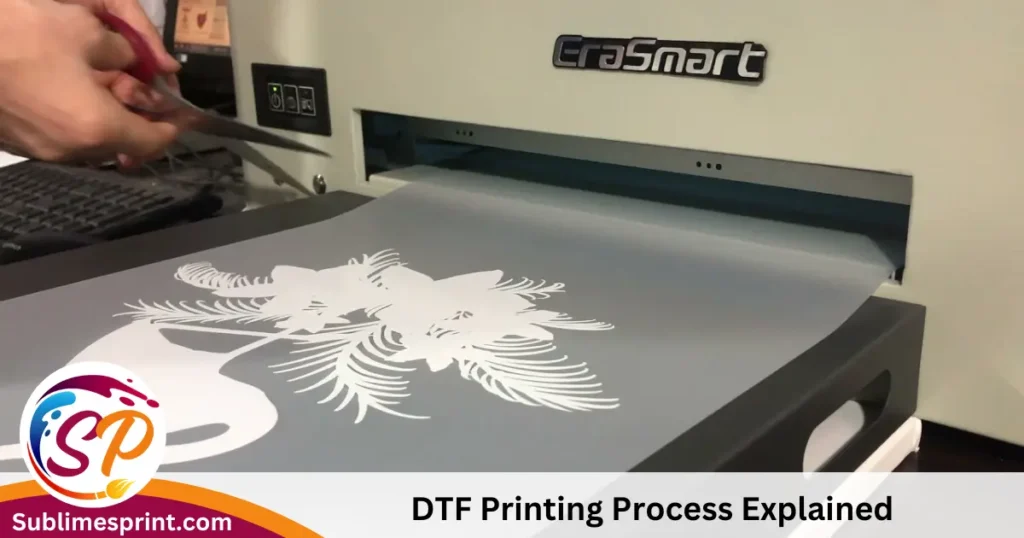
Now that your print shop is equipped with a DTF printer and high-quality sublimation ink, let’s demystify the captivating process of DTF printing. This section will guide you through each step, from preparing your design to the final curing and finishing touches.
Preparing the Design for DTF Printing
1. Digital Design Considerations:
- Ensure your digital design is high-resolution for optimal print quality.
- Adjust color profiles to match the capabilities of your sublimation ink.
2. Choosing the Right Film:
- Select a compatible film that suits the intricacies of your design.
- Ensure the film is properly sized to match the print area of your garment.
3. Film Printing:
- Load the chosen film into your DTF printer.
- Adjust printer settings to match the characteristics of the film.
Step-by-Step Printing Process Using Sublimation Ink
1. Film Application:
- Carefully apply the printed film onto the garment fabric.
- Ensure even and secure placement for accurate transfers.
2. Heat Transfer Process:
- Use a heat press to apply heat and pressure to the film and fabric.
- Sublimation ink transforms into a gas, permeating the fabric fibers.
3. Curing Stage:
- Allow the garment to cool briefly after heat pressing.
- Cure the print by subjecting it to a specific temperature and duration.
4. Peeling and Inspecting:
- Gently peel off the film after curing.
- Inspect the print for quality, ensuring vibrant colors and sharp details.
Curing and Finishing Techniques for DTF Prints
1. Post-Curing:
- Consider a post-curing process for added durability.
- Follow manufacturer guidelines for specific ink curing requirements.
2. Wash Testing:
- Conduct wash tests to assess the ink’s wash fastness.
- Document and share the results with your customers for transparency.
Ensuring Quality Throughout the Process
- Regular Maintenance Checks:
- Implement a routine maintenance schedule for your DTF printer.
- Check and clean print heads, ensuring consistent ink flow.
- Quality Control Measures:
- Introduce quality control checks at each stage of the printing process.
- Address any issues promptly to maintain high standards.
Read also: Can I Use Pink Butcher Paper For Sublimation
Quality and Innovation in Custom Apparel Printing
Welcome to the realm of innovation and quality that DTF printing with sublimation ink brings to your custom apparel printing business. In this section, we’ll explore the profound impact that DTF can have on the quality of your prints and how it positions your print shop as a trendsetter in the competitive world of custom apparel.
How DTF Elevates Print Quality
1. Vibrancy Beyond Imagination:
- DTF printing, coupled with sublimation ink, produces colors that pop.
- The process ensures that each hue is vivid and true to the original design.
2. Intricate Detail and Clarity:
- Say goodbye to compromises in detail; DTF captures intricate designs flawlessly.
- Fine lines, gradients, and small text are reproduced with astonishing clarity.
3. Durability that Endures:
- DTF prints, thanks to sublimation ink, become part of the fabric, not just on it.
- This integration results in prints that outlast traditional methods, resisting fading and wear.
Case Studies: Success Stories in DTF Printing
1. Print Shop X:
- Increased customer satisfaction by 30% after adopting DTF printing.
- Positioned themselves as leaders in high-quality custom apparel within the local market.
2. Innovative Designs, Happy Customers:
- Print shops embracing DTF reported a surge in customer engagement.
- Unique designs and vibrant prints set them apart, fostering customer loyalty.
Impact on Customer Satisfaction and Repeat Business
1. Customer Delight:
- DTF prints amaze customers with their visual appeal and soft feel.
- Delighted customers are more likely to become repeat buyers.
2. Word of Mouth Marketing:
- Happy customers become brand advocates, spreading the word about your innovative prints.
- Word of mouth is a powerful marketing tool in the custom apparel industry.
Balancing Innovation with Traditional Methods
1. Selective Integration:
- Determine the right balance between DTF printing and traditional methods for your business.
- Some designs may benefit more from the precision of DTF, while others suit traditional techniques.
2. Market Research and Adaptation:
- Stay attuned to market trends and customer preferences.
- Adapt your printing strategies to align with evolving fashion and design trends.
DTF vs. Traditional Printing Methods: A Comparative Analysis
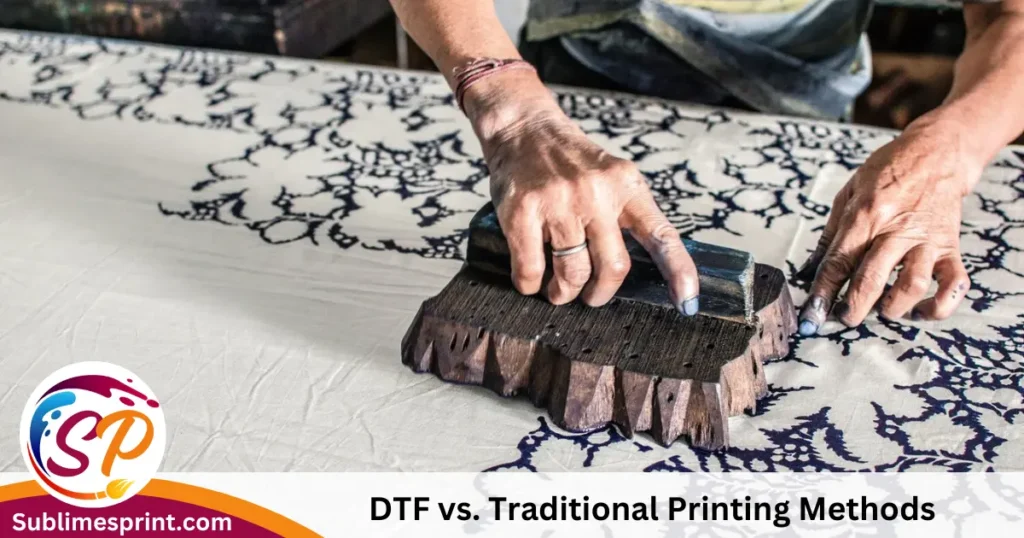
As we approach the crossroads of innovation and tradition, it’s essential to conduct a thorough analysis of how DTF printing with sublimation ink stacks up against traditional printing methods. In this section, we’ll explore the costs, considerations, and return on investment, empowering you to make informed decisions for your custom apparel business.
Comparative Cost Considerations
1. Initial Investment:
- DTF printing may require a higher initial investment in specialized equipment.
- Traditional methods, like screen printing, might have a lower upfront cost.
2. Per-Unit Production Costs:
- DTF printing can offer cost savings in large-scale production due to efficiency.
- Traditional methods may become cost-effective for smaller batches.
Return on Investment (ROI) in DTF Printing
1. Efficiency and Throughput:
- DTF printing’s direct process can lead to higher production throughput.
- Faster production may result in a quicker return on your initial investment.
2. Diversification of Offerings:
- DTF’s versatility allows for a broader range of designs and materials.
- Attracting diverse customers can enhance your business’s overall profitability.
Adapting to Industry Trends and Staying Competitive
1. Staying Ahead with DTF:
- DTF printing aligns with the demand for intricate, vibrant designs.
- Its adaptability positions your business as an industry trendsetter.
2. Traditional Methods’ Niche Appeal:
- Certain niches or design preferences may still favor traditional printing.
- Combining both methods allows for flexibility in meeting diverse customer needs.
Strategic Tips for Print Shop Success
1. Hybrid Approach:
- Consider adopting a hybrid approach, integrating both DTF and traditional methods.
- Leverage the strengths of each method for different design requirements.
2. Customer Education:
- Educate your customers on the benefits of DTF printing.
- Highlight the unique qualities that set DTF prints apart in terms of quality and durability.
Tips for a Successful Custom Apparel Business in the DTF Era
Congratulations on navigating the intricate landscape of DTF printing with sublimation ink! As we approach the final leg of this comprehensive guide, let’s delve into practical tips that will empower your custom apparel business to thrive in the dynamic era shaped by DTF innovation.
1. Leveraging DTF Printing for Customer Attraction
a. Showcase Your Unique Designs:
- Use DTF’s capability to capture intricate details to showcase unique designs.
- Create a portfolio that highlights the vibrancy and precision achievable with DTF prints.
b. Offer Limited Edition Prints:
- Create a sense of exclusivity by offering limited edition DTF prints.
- Limited runs can drive demand and customer engagement.
2. Incorporating DTF into Your Marketing Strategy
a. Educate Your Audience:
- Develop content that educates your audience on the benefits of DTF printing.
- Use blog posts, social media, and video content to showcase the magic of DTF.
b. Collaborate with Influencers:
- Partner with influencers in the fashion and design space to showcase DTF prints.
- Influencers can help amplify your message and reach a broader audience.
3. Balancing Innovation with Traditional Prints
a. Offer a Diverse Range of Printing Services:
- Balance your offerings by providing both DTF and traditional printing services.
- Cater to a wide range of customer preferences and design requirements.
b. Customization Options:
- Leverage DTF’s versatility to offer customized prints on various fabrics.
- Allow customers to personalize their garments for a unique touch.
4. Customer Satisfaction as a Priority
a. Transparent Communication:
- Communicate transparently with customers about the DTF printing process.
- Set expectations regarding the durability, care, and unique characteristics of DTF prints.
b. Quality Control Measures:
- Implement stringent quality control checks at every stage of the printing process.
- Ensure that each DTF print leaving your shop meets the highest standards.
5. Embracing Continuous Learning and Innovation
a. Stay Updated on Industry Trends:
- Keep a pulse on evolving fashion and design trends in the industry.
- Adapt your printing techniques to align with emerging customer preferences.
b. Invest in Training and Development:
- Invest in ongoing training for your team to stay updated on DTF printing advancements.
- A skilled and knowledgeable team is key to maintaining high-quality standards.
FAQs
Is DTF ink and sublimation ink the same?
No, DTF ink (Direct to Film) and sublimation ink are not the same. DTF ink is a type of ink designed for direct printing onto a special film, which is then transferred to fabric. Sublimation ink, on the other hand, is intended for a different process where the ink transforms from a solid to a gas under heat, embedding the design into materials like fabric. Each ink serves a specific printing method with distinct characteristics.
What ink is used for DTF printing?
DTF printing typically uses DTF ink, which is a type of aqueous ink suitable for printing on the film used in the DTF process. This ink is formulated to adhere well to the film and transfer accurately onto the fabric during the printing process.
Does DTF last as long as sublimation?
The longevity of DTF prints can be comparable to sublimation prints. Both methods offer durable prints when done correctly. DTF prints, with proper curing and care, can withstand washing and wear. However, the specific durability depends on factors like ink quality, curing processes, and material types.
Can an Epson Ecotank be used for DTF printing?
Yes, some Epson EcoTank models can be used for DTF printing. EcoTank printers, known for their refillable ink tanks, can be suitable for DTF setups. It’s essential to check the printer’s specifications and ensure compatibility with DTF ink and film. Some models may require modifications for optimal DTF performance.
Can I use DTF on tumblers?
DTF printing is primarily designed for fabric materials, and it may not be the best choice for tumblers. For cylindrical or curved surfaces like tumblers, methods such as UV printing or sublimation are more commonly used. These techniques offer better adherence to non-flat surfaces.
What Epson printers can print DTF?
Several Epson printers are compatible with DTF printing. Models like the Epson SureColor F2100 and F570 are known for their compatibility with DTF setups. However, always check the specific printer model and verify that it meets the requirements for DTF printing.
Can you use an inkjet printer for DTF film?
Yes, DTF film is designed to work with inkjet printers. The film is coated to receive inkjet inks effectively. When using an inkjet printer for DTF film, it’s crucial to choose a printer with good color reproduction and ensure that the ink is compatible with the film for optimal results.
Conclusion:
Your Journey into DTF Printing Excellence
Remember that mastering DTF printing with sublimation ink is not just about adopting a new technique; it’s about unlocking a realm of creativity and possibilities for your custom apparel business. By integrating DTF into your workflow and embracing the unique advantages it offers, you position your print shop as a beacon of innovation in the industry.
As you embark on your continuous journey into DTF printing excellence, these resources will serve as valuable companions, providing support, knowledge, and inspiration. Remember, the world of custom apparel printing is dynamic, and staying ahead requires a commitment to learning, innovation, and a passion for delivering exceptional quality to your customers. Additional Resources and References
Congratulations on reaching the final section of our comprehensive guide to mastering DTF printing with sublimation ink! To further support your journey into the world of innovative custom apparel printing, we’ve compiled a list of additional resources and references. These resources will provide in-depth insights, expert advice, and tools to help you continually enhance your DTF printing capabilities.
1. Equipment and Supplies:
- DTF Printers Guide – Explore a curated list of DTF printers, their specifications, and user reviews.
- Sublimation Ink Suppliers – Connect with reliable suppliers offering high-quality sublimation inks for DTF printing.
2. Learning and Training:
- DTF Printing Webinars – Attend webinars hosted by industry experts to deepen your understanding of DTF printing techniques.
- Online Courses – Enroll in online courses covering DTF printing, sublimation ink usage, and advanced printing techniques.
3. Community Forums and Discussions:
- Print Shop Owners Forum – Join discussions with fellow print shop owners to share experiences and insights on integrating DTF into your business.
- DTF Printing Communities – Engage with online communities dedicated to DTF printing for valuable tips and troubleshooting advice.
4. Industry Reports and Whitepapers:
- State of Custom Apparel Printing Report – Access industry reports outlining the current trends, challenges, and opportunities in custom apparel printing.
- Whitepaper on DTF Innovations – Dive into a comprehensive whitepaper discussing the latest innovations in DTF printing technology.
5. Design Inspiration and Trends:
- Design Trends Blog – Stay inspired with a blog featuring the latest design trends in the custom apparel industry.
- DTF Print Galleries – Explore curated galleries showcasing stunning DTF prints for creative inspiration.
6. Practical Guides and Tutorials:
- DTF Printing Setup Guide – Step-by-step guide on setting up your DTF printing equipment for optimal performance.
- Sublimation Ink Handling Tips – Practical tips for handling sublimation ink to ensure consistent and vibrant prints.
7. Industry Events and Expos:
- Custom Apparel Printing Expo Calendar – Stay updated on upcoming events and expos focused on custom apparel printing and DTF technology.
- DTF Printing Demos – Attend live demonstrations at industry events to witness the latest DTF printing techniques in action.
8. Recommended Reading:
- Books on DTF Printing – Explore a curated list of books providing in-depth insights into the art and science of DTF printing.
Wishing you vibrant prints, satisfied customers, and continued success on your DTF printing adventure!

I’m James Wilson, the driving force behind “Sublimes Print.” I’ve been deep in the world of sublimation printing, bringing my expertise and hands-on experience to the table. With a robust background in the art of sublimation printing, I’m all about sharing insights, exploring industry innovations, and fostering a collective appreciation for the craft.
So, join me on this printing journey, where we dive into the intricacies of sublimation and celebrate the beauty it brings to the world of printing!
